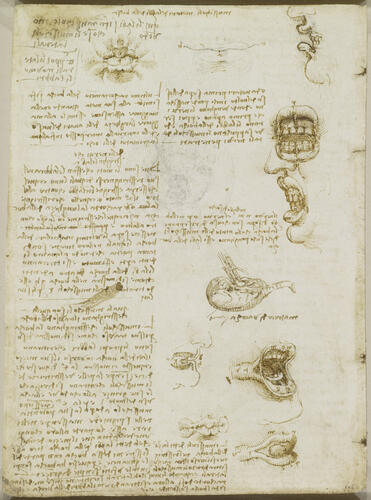-
1 of 253523 objects
Recto: The uterus of a gravid cow. Verso: The anatomy of the mouth c. 1508
Traces of black chalk, pen and ink | 19.2 x 14.2 cm (sheet of paper) | RCIN 919055
-
A folio from Leonardo's 'Anatomical Manuscript B'.
Recto: A page from a notebook showing the dissection of a pregnant cow. The drawings show the two-chambered bovine uterus, with a calf in the upper chamber. In the lower study Leonardo removes the uterine wall to show the calf; the placenta is represented as a pattern of small ovals.
This is one of Leonardo’s great studies of in utero development. The upper drawing is an external view of the bipartite uterus of a cow, with the vagina to the left, the ovaries and their suspensatory ligaments at the centre, and the blood supply from below. The upper section of the uterus is gravid, and Leonardo has lightly indicated the individual portions of the multiple, cotyledenous placenta as a pattern of small ovals. In the lower study the uterine wall has been removed to show the chorionic membrane, with countless vessels arising in the chorion and uniting to form the fetal blood supply, coursing to the umbilicus of the calf. The fetal calf is visible, on its back with its head to the left and its legs upwards. The lower, non-gravid portion of the uterus spirals away in an excessively stylised manner, and the individual cotyledons of the placenta are dotted to represent their supposedly digitated form.
Leonardo understood the placenta as a union of maternal and fetal tissues, and in the small sketch at lower right he shows them peeling apart to demonstrate their interdigitation (cf. 919046, 919102). On 919095v he had noted that ‘the child turns with its head downwards on the separation of the cotyledons’, and indeed his later drawings of the child in the womb show that he believed that the child sat in breech position until shortly before birth (919101-3). Leonardo also knew that, despite the multiple, cotyledenous structure of the bovine placenta, the afterbirth was expelled as a single entity, and he explained this as a union of the fetal cotyledons when the uterus contracted after parturition – as illustrated in the sketch of hexagons at upper left. Around the lower drawing he wrote:
"This drawing below contains the third and fourth sloughed membranes [chorion and amnion] of the animal enclosed in the uterus. These membranes are united, that is, they are in contact with each other, and that which is more superficial is united with this [the uterus] through the fleshy rosettes [cotyledons] which interlock and stick together as burrs do with each other. And at birth the infant carries with it these two coats with half the thickness of these rosettes, and the other half remains within the uterus of the mother, which then in contracting joins them together ... in such a way that they would never appear to have been separated. And the sloughed membrane in contact with the animal which is born has none of these fleshy rosettes."
Although the page is headed ‘uterus of the cow’, these notes refer not to cow and calf but simply to mother (or animal) and infant. Leonardo assumed that all mammals had essentially the same reproductive structures, and in his embryological studies of a few years later he applied to the human form the cotyledenous placental structure that he had observed in the cow.
Verso: Leonardo wrote at the head of this page ‘the motor muscles of the lips of the mouth’, and most of the studies examine the muscles that pull the mouth into a wide range of expressions – naturally, of great interest to an artist. At centre left is a sketch of the bovine uterus, as studied in more detail on the recto.
Text adapted from M. Clayton and R. Philo, Leonardo da Vinci: Anatomist, London 2012Provenance
Bequeathed to Francesco Melzi; from whose heirs purchased by Pompeo Leoni, c.1582-90; Thomas Howard, 14th Earl of Arundel, by 1630; probably acquired by Charles II; Royal Collection by 1690
-
Creator(s)
Acquirer(s)
-
Medium and techniques
Traces of black chalk, pen and ink
Measurements
19.2 x 14.2 cm (sheet of paper)
Other number(s)
Alternative title(s)
Recto: The uterus of a gravid cow. Verso: Studies of the movement of the lips

